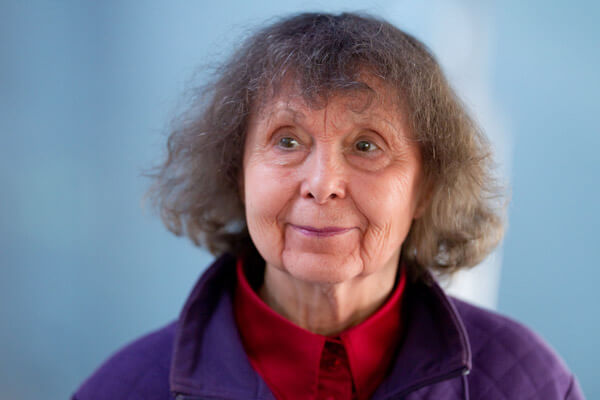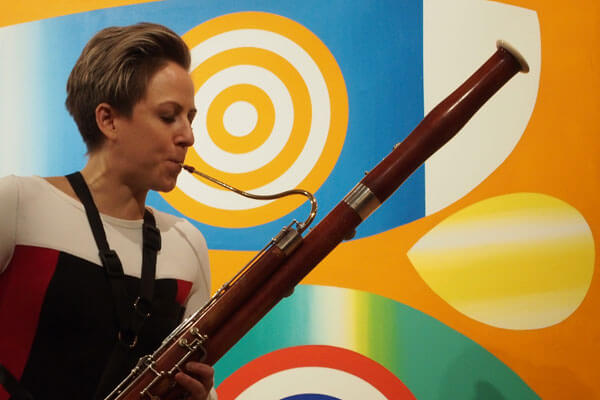 When I discovered that the International Contemporary Ensemble (ICE) was putting on an all-Gubaidulina program at Columbia University’s Miller Theatre on February 9, 2013, I jumped at the chance to attend. Sofia Gubaidulina certainly stands as one of the best and most original composers of the last several decades. Using cutting-edge instrumental techniques to great effect, Gubaidulina’s music is painted with innovative strokes of sound. Add to this canvas a compelling sensibility for solo voices that gives each composition different characters to work with, and the result is always fascinating. ICE, with its large pool of solid instrumentalists, seems capable of pulling off anything, no matter how difficult the score and how wacky the instrumentation. This makes them well-positioned to bring to life Gubaidulina’s always interesting selections of instrumentation, chosen with a deep knowledge of what the instruments are capable of and how to push their limits. Indeed, ICE’s Composer Portrait concert of works by Gubaidulina at Miller Theatre proved the prowess of composer and ensemble alike.
When I discovered that the International Contemporary Ensemble (ICE) was putting on an all-Gubaidulina program at Columbia University’s Miller Theatre on February 9, 2013, I jumped at the chance to attend. Sofia Gubaidulina certainly stands as one of the best and most original composers of the last several decades. Using cutting-edge instrumental techniques to great effect, Gubaidulina’s music is painted with innovative strokes of sound. Add to this canvas a compelling sensibility for solo voices that gives each composition different characters to work with, and the result is always fascinating. ICE, with its large pool of solid instrumentalists, seems capable of pulling off anything, no matter how difficult the score and how wacky the instrumentation. This makes them well-positioned to bring to life Gubaidulina’s always interesting selections of instrumentation, chosen with a deep knowledge of what the instruments are capable of and how to push their limits. Indeed, ICE’s Composer Portrait concert of works by Gubaidulina at Miller Theatre proved the prowess of composer and ensemble alike.
The highlight for me was the Concerto for Bassoon and Low Strings. The instrumentation alone was enticing and proved effective. I was especially taken with the third movement, in which the bassoon drops out and the low strings move together as though there was a slight haze covering them and then break free from one another to create a whole different kind of sound cloud – this one disjunct and chaotic, a ruckus of distinct individuals. Another great moment was the final bassoon cadenza. Soloist Rebekah Heller was lively and riveting here, especially in her descending pitch bends that almost laughed their way out of the instrument. Likewise, her brash multiphonics were moments to take in the bassoon’s capabilities; it’s rare that you get to see this instrument on such bold display. The Concerto allows for the bassoon to play many different characters, going from light-hearted to raucous often from one passage to the next. Heller let go and let her instrument run wild, which I think is what this piece calls for.
Another standout that night was Concordanza, scored for flute, oboe, clarinet, bassoon, horn, percussion, violin, viola, cello, and bass: essentially a string quartet plus a wind quintet, along with assorted percussion. The flowing opening gave way to disjointed, heavily articulated conversations of soloists. Much of the piece explored this contrast of material, essentially Gubaidulina’s approach to consonance vs. dissonance in this work. My favorite moment was a fugal passage in the woodwinds with a subject that sounded like it was asking questions rather than giving answers and never quite sure of itself (and I mean that in a good way). Benjamin Fingland’s clarinet statement of the subject was a strong point, really getting into the character of the passage and holding back nothing emotionally. The drastic contrasts of timbre, articulation, and dynamics in his playing were quite impressive. When Ross Kare answered the woodwinds with a restatement of the subject on percussion, it was a good reminder that gesture and phrasing are really what matters, and the fugal imitation of woodwinds by drums was impressive.
Unfortunately some of the other playing was a bit flat in expression for my tastes, though always technically well executed. And I’m not sure everything always quite gelled as an ensemble, but perhaps this was just a matter of limited rehearsal time for a challenging and unique piece. Nevertheless some great ensemble moments emerged, particularly some harsh sonorities between the horn and woodwinds and a mallet tremolo providing background to soloistic passages.

Composer Sofia Gubaidulina (photo credit: www.remusik.org)
The other works performed that night were Trio, for violin, viola, and cello, and Meditation on the Bach Chorale “Vor deinen Thron tret’ ich hiermit.” The conversational element in the Trio was quite intriguing, with the often disparate individual voices reminding me a bit of Ives (conceptually, not stylistically). Towards the end, a well-executed ostinato in the upper reaches of the violin while the viola was feverishly plucking away was quite spectacular. Meditation, scored for harpsichord, string quartet, and double bass, brought elements of Bach in and out of focus within Gubaidulina’s chilling string textures and a use of the harpsichord I’ve never heard before. Overall this concert was a great opportunity to really take in Gubaidulina’s music in all its richness.
–
David Pearson is a saxophonist residing in NYC and a doctoral candidate in musicology at CUNY Graduate Center.





















